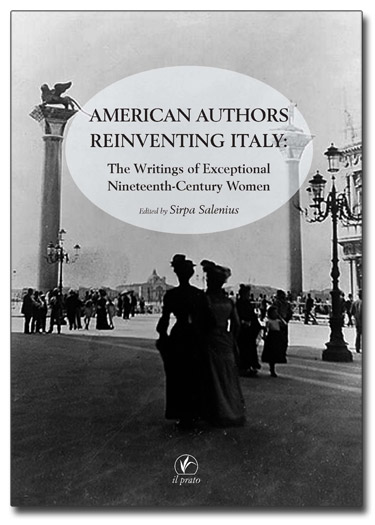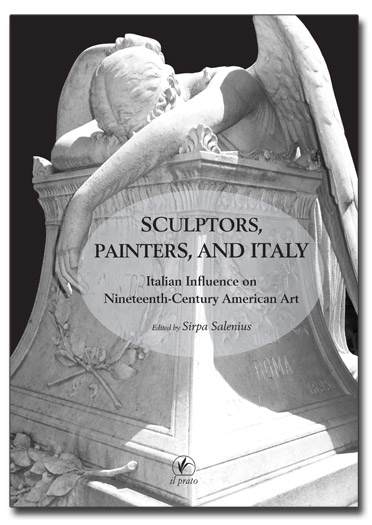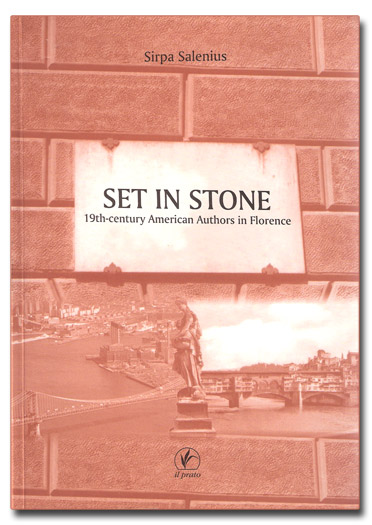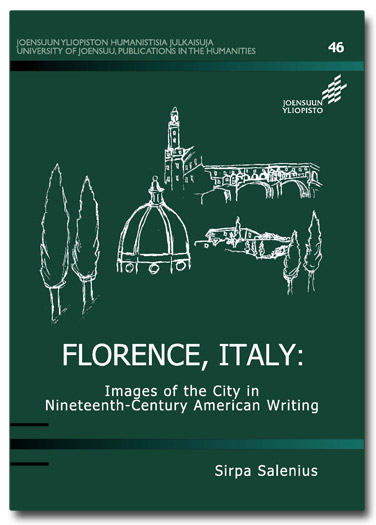Books by SIRPA SALENIUS |
Sirpa Salenius is the editor of the OltreOceano-TransAtlantic Transitions book series on nineteenth-century American artists and writers in Italy. Her publications examine the Grand Tour and the influence of Italy on the lives and works of such American authors and artists as James Fenimore Cooper, Nathaniel Hawthorne, Mark Twain, Henry James, Harriet Beecher Stowe and John Singer Sargent.
Ms. Salenius, a native of Finland, has been teaching English and American literature at American University study abroad programs in Rome and Florence (Richmond, the American International University in London – Rome Program and the University of New Haven in Florence). Her Ph.D. in English studies is from the University of Joensuu (Finland).
|
American Authors Reinventing Italy: The Writings of Exceptional
Nineteenth-Century Women (2009, published by Il Prato: OltreOceano-TransAtlantic Transitions series, 15.00€) is a collection of scholarly papers that examine Italy in the writings of such American women as Margaret Fuller, Harriet Beecher Stowe, Constance Fenimore Woolson, and Edith Wharton.
The introduction provides a general picture of the British and American female authors in Italy—especially in Florence—and discusses the works of such writers as Elizabeth Barrett Browning, Ouida, Violet Paget, Kate Field, and Francesca Alexander.
In the essay that forms Chapter One, Debra Bernardi (Carroll College, Montana) examines sexuality in Margaret Fuller´s Italian writings.
In Chapter Two, Philip J. Kowalski (Wake Forest University, North Carolina) analyzes Harriet Beecher Stowe’s views on Italy from her travel texts and her novel set in Italy.
In Chapter Three, Sirpa Salenius (University of New Haven in Florence, Italy), looks at the way Constance Fenimore Woolson uses
Italian tropes in her discussion of contemporary issues.
In Chapter Four, Virginia Ricard (University of Bordeaux, France) discusses themes, settings, and characters that deal with Italy in Edith Wharton’s fiction and non-fiction writing. |
|
| |
The essays in Sculptors, Painters, and Italy: Italian Influence on Nineteenth-Century American Art (2009, published by Il Prato: OltreOceano-TransAtlantic Transitions series, 15.00€) examine the influence of Italy on the works of nineteenth-century American sculptors and painters.
The focus is on
their experience in Italy, their relationship with local workmen, their
contact with Italian artists (e.g., the Tuscan Macchiaioli), and the impact
of their Italian experience on the formation of American art.
The papers
in the volume discuss such artists as Horatio Greenough, Thomas Cole,
Hiram Powers, Henry Kirke Brown, Elihu Vedder, Edmonia Lewis, and
John Singer Sargent.
The essays are written by scholars from American
universities and museums, and they appear in the following order: Elise
Madeleine Ciregna, “’An Example in the Right Direction’: Horatio
Greenough’s Life and Work in Italy”; John F. McGuigan Jr, “’A Painter’s
Paradise’: Thomas Cole and His Transformative Experience in Florence,
1831-1832”; Rebecca Reynolds, “’No Ordinary Hands’: Hiram Powers’
Artistic and Professionally Related Family”; Karen Lemmey, “’I would
just as soon be in Albany as Florence,’ Henry Kirke Brown and the
American Expatriate Colonies in Italy, 1842-1846”; Mary K. McGuigan,
“A Garden of Lost Opportunities: Elihu Vedder in Florence, 1857-1860”,
Marilyn Richardson, “Friends and Colleagues: Edmonia Lewis and Her
Italian Circle”; and Kathleen Lawrence, “John Singer Sargent, Italy, and
the American Paradox.” |
|
| |
Set in Stone: 19th-century American Authors in Florence (2003, published by Il Prato: OltreOceano-TransAtlantic Transitions series, 109 pages, 15.00€) is a study of American authors whose Florentine sojourns have been honored with commemorative plaques in the city as well as its immediate surroundings.

The writers included in the volume are Mark Twain, James Fenimore Cooper, Nathaniel Hawthorne, Henry James, Henry Wadsworth Longfellow, and James Russell Lowell.
They all resided temporarily in Florence in the 19th century and most of them found the relaxed, dolce-far-niente, atmosphere of the city ideal for creative work. The city and its long history inspired the authors, stirring their imaginations.
The volume gathers written testimonies of the impressions Florence awoke in these acclaimed visitors. Quotations have been taken from their writings—be they diaries, letters, autobiographies, novels or poems—in testimony to the importance of the Florentine sojourn to their lives and careers.
Photographs and old postcards accompany the selected excerpts in order to offer the reader a comparison between the literary texts produced by the authors and the physical reality that inspired them. |
|
| |
Florence, Italy: Images of the City in Nineteenth-Century American Writing (2003, published by Il Prato: OltreOceano-TransAtlantic Transitions series, 15.00€) examines the impressions of Florence in non-fictional and fictional writing of
such American authors as James Fenimore Cooper, Henry Wadsworth
Longfellow, Nathaniel Parker Willis, Margaret Fuller, Nathaniel Hawthorne,
Mark Twain (Samuel Clemens), Henry James, Constance Fenimore Woolson,
William Dean Howells and Edith Wharton.
The volume demonstrates that the
diverse textual presentations of the city in nineteenth-century American writing stem from conventional ideas of Florence as the touristic capital of art as evidenced its in paintings, monuments, churches and
aristocratic villas.
In addition to urban tropes, the book discusses the idealized rural scenery. The landscape is described as “Arcadia” and “Eden” and defined in
such religious terminology as “divine,” “heaven” and “Paradise.”
When
creating their Florentine fictional characters, the American writers were influenced by the racial beliefs of the period. Indeed, as the thesis shows, while writing about Florence, the American authors
remain intricately interconnected with American realities. The writers’ constructions of Florence are influenced by the dominant contemporary
American prejudices and prevailing ideologies. Consequently, Florence often is
used as a backdrop for addressing such issues as the problems linked with urbanization, immigration, and gender, class and racial definitions. In this way,
nineteenth-century American images of Florence remain inseparable from
the historical and cultural context of their time. |
|
NOTE: The publisher has not had a chance to update his web pages yet, so only Set in Stone appears on his site. If you wish to purchase any of the other books, please contact the publisher: ilprato@libero.it.
To contact Sirpa: salenius@libero.it
Web page designed by Web Star Lines, Ltd.
|



